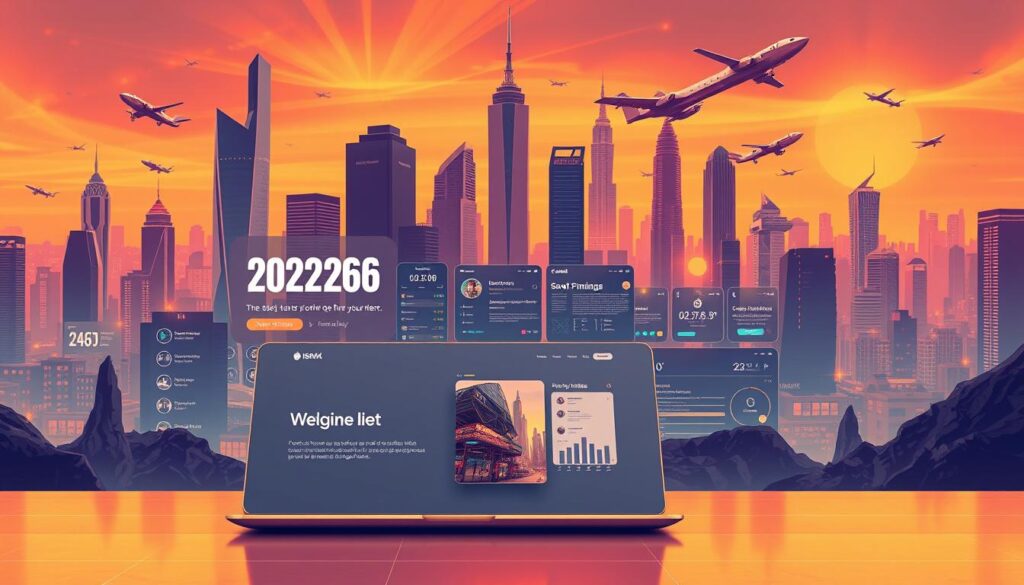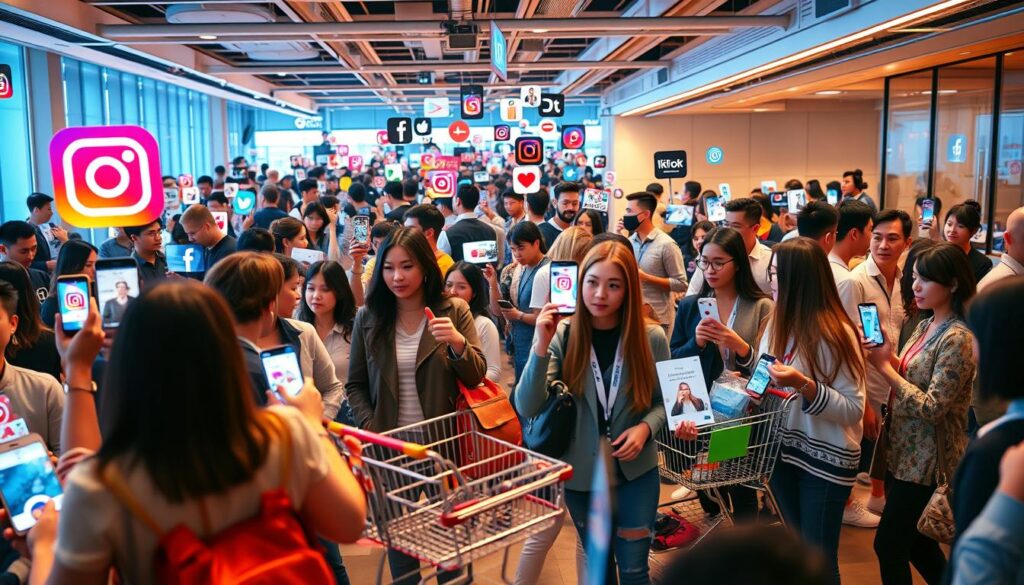
Surprising fact: nearly 93.5% of internet users have bought online, and 80% shop on mobile devices — a scale that makes your online presence the primary storefront for any business in the United States.
Simplicity pays. Studies show 76% of consumers prefer simple, elegant pages. That preference cuts bounce rates and raises trust, which directly affects revenue.
This forward-looking listicle unpacks 12 specific web design choices that reduce friction, increase mobile traffic, and improve user experience for online retailers. Each trend ties to measurable outcomes like lower abandonment, higher order value, and longer sessions.
What to expect: actionable steps, examples for Shopify and WooCommerce, and a pragmatic roadmap that aligns brand storytelling with fast-loading pages and clear information. Read on to see how modern web choices turn pages into a high-performing sales engine.
Key Takeaways
- Mobile optimization and responsive layouts will drive most traffic and conversion gains.
- Elegant, simple interfaces increase trust and reduce bounce.
- Each trend links to measurable metrics: abandonment, AOV, and session duration.
- Practical implementation notes cover Shopify and WooCommerce workflows.
- Focus on fast pages, clear information, and fewer steps for the user.
Why Conversion-Focused Design Will Define E‑Commerce Growth in 2026
Smart interfaces map intent to outcome, making the path from discovery to checkout obvious and fast.
Conversion-focused design means aligning interface elements, navigation, and content so each interaction nudges a buyer forward.
Understanding commercial intent and the path to purchase
Map the customer journey from landing to checkout. Use clear page hierarchy, visible trust markers, and concise messaging.
Result: shorter decision times, lower bounce rates, and higher average order value.
Aligning simplicity and elegance with revenue goals
Simplicity reduces cognitive load. Elegant pages help users decide faster on phones and desktops alike.
“Good interface choices remove friction; they make good business sense.”
- Place CTAs where attention naturally lands.
- Keep product content clear: specs, FAQs, and policies answer objections.
- Prioritize responsive, accessible layouts for wider reach.
| Focus | Action | Metric | Impact |
|---|---|---|---|
| Hierarchy | Clear headings & CTA placement | Click-through rate | Faster path to checkout |
| Trust | Badges & consistent brand voice | Bounce rate | Higher conversions |
| Accessibility | One-handed nav & readable type | Session duration | Broader audience reach |
Tip: run A/B tests to validate which elements lift add-to-cart and completion rates. Iterate steadily to match ambition with team capacity.
website design trends 2026: The Must‑Watch List for Sales Impact
12 focused visual and interaction moves map directly to clearer pages, less checkout friction, and higher perceived product value.
Emerging approaches—3D depth blended with 2D, split‑screen layouts, asymmetry, micro animations, organic and geometric shapes, monochrome palettes with accents, maximized typography, masking, and simplified line/isometric illustrations—each improve engagement when paired with a strict performance budget.
Prioritize wisely: not every brand needs every trend. Pick the few that match your audience and product tone.
Combine thoughtfully: for example, an asymmetric split screen with large type and subtle micro motion can tell a stronger story on a hero page without slowing load times.
- Map each trend to a metric: conversion rate, revenue per session, and checkout completion time.
- Adopt milestone releases and measure before/after results.
- Use the included platform guidance for Shopify and WooCommerce to cut integration friction.
- Document ROI for stakeholders with clear A/B tests and tracking.
“Visual innovation wins attention; disciplined performance protects conversion.”
| Trend | Primary Benefit | Performance Note | Example Use |
|---|---|---|---|
| 3D + 2D depth | Higher engagement | Use lightweight models; lazy load | Product hero demo |
| Split screens & asymmetry | Clear hierarchy | Responsive breakpoints matter | Feature vs. social proof |
| Maximized typography | Faster scanning | System fonts + smart fallbacks | Campaign landing pages |
| Micro animations & illustrations | Action guidance | Limit motion to key interactions | Micro‑interaction for add‑to‑cart |
For practical examples and tools, see a roundup of leading web examples. Use that as a launchpad for milestone planning and rapid testing.
AI‑Driven Personalization That Adapts in Real Time
Real-time AI adapts banners, product suggestions, and messaging to match a user’s behavior and lifecycle stage. This raises engagement and satisfaction by making content feel relevant and immediate.
From predictive recommendations to dynamic content blocks
Predictive recommendations lift average order value by surfacing complementary items on product pages, carts, and checkout. Models use viewed categories, search queries, and cart events to rank suggestions.
Dynamic content blocks swap headlines, imagery, and offers for segments like first-time visitors or repeat buyers. That reduces friction and shortens decision time.
Shopify and WooCommerce tools that operationalize personalization
Use Shopify Recommender or WooCommerce Product Recommendation plugins to deploy AI suggestions fast and cut development time. Add privacy controls, frequency caps, and opt-in choices to keep trust high.
- Test placements with A/B and multi-armed bandit experiments.
- Track CTR on recommendations, conversion uplift, and revenue per session.
- Limit swaps and scripts with a strict performance budget.
“Personalization works best when it respects privacy and keeps the core brand consistent.”
| Use | Benefit | Metric |
|---|---|---|
| Homepage modules | Higher engagement | CTR |
| Product page suggestions | Higher AOV | Revenue/session |
| Cart cross-sells | Lower abandonment | Conversion rate |
Immersive 3D and Augmented Reality That Reduce Returns
High-fidelity 3D and AR let shoppers inspect items as if they held them, cutting guesswork that fuels returns.
Business case: richer product visualization reduces uncertainty, raises buyer confidence, and lowers costly returns. Virtual try-on for apparel, eyewear, and cosmetics replicates in‑store fitting and lifts add‑to‑cart rates.
Virtual try-on and interactive product demos that close the gap to in‑store
Interactive 3D demos help for electronics, furniture, and gear. Users can rotate, zoom, and view exploded parts to learn features quickly.
Performance tactics for mobile devices and low‑latency rendering
Optimize assets: mesh reduction, texture compression, GPU‑friendly materials, and progressive loading keep pages fast on small devices.
Use conditional loading so 3D and AR initialize only after user interaction. Pair Three.js, Blender exports, or Spline with a global CDN for low latency.
“Start with top sellers, measure return reduction and dwell time, then scale models and governance.”
| Use case | Primary benefit | Performance note |
|---|---|---|
| Virtual try-on (apparel) | Fewer returns, higher confidence | Lightweight scans, conditional load |
| 3D demos (electronics) | Lower support queries, better conversion | Texture LOD, GPU materials |
| AR for furniture | Accurate sizing in room | CDN delivery, cached assets |
Conversational Commerce and Voice Shopping Built for Speed
Conversational interfaces turn search into a natural talk-and-tap experience that shortens discovery time.
What it is: conversational commerce covers voice and chat-led interactions that streamline product discovery and checkout across devices.
Voice navigation, NLP keywords, and accessibility
Use natural language phrases and long-tail queries in headings and FAQ content to match how people speak. Add question-based schema markup so assistants surface the right pages.
Voice-first patterns should map simple navigation paths and brief microcopy for fast responses. This improves findability and the overall user experience.
AI chatbots for frictionless assistance
Chatbots can handle product discovery, order status, and returns. Start with FAQs and order-tracking flows, then expand to guided selling with personalization logic.
- Monitor task completion, time to answer, CSAT, and chat-assisted conversions.
- Protect data with secure endpoints, clear opt-outs, and quick human escalation.
- Defer heavy scripts and use server-side endpoints for snappy interactions.
“Keep tone clear, brief, and aligned with brand voice to build trust.”
Micro‑Interactions and Motion UI that Guide Decisions
Micro-interactions turn short moments into clear signals. They show success, failure, or progress with tiny motion instead of long text. This helps users act with confidence on product pages and checkout flows.

How subtle motion communicates state: a brief add-to-cart pulse, a saved bookmark bounce, or a gentle error shake. These cues reduce doubt and speed task completion without adding cognitive load.
Use motion for affordances like hover, press, and drag so interactive elements read as interactive. Keep animations short and vector-based to protect performance.
- Consistency: match easing and duration to build a single motion language.
- Performance checklist: vector assets, compressed JSON (Lottie), deferred loading.
- Tools: LottieFiles, Framer, After Effects for efficient, lightweight animations.
- Accessibility: honor reduced motion settings at the OS or browser level.
Test and measure: experiment with variants to track click-through and completion rates. Use motion to pull attention to primary CTAs but avoid over-animation that distracts or slows pages.
“Motion should always serve content and conversion goals, not just visual flair.”
Document tokens and patterns in a shared motion pattern library so designers and developers reuse the same rules. This creates a cohesive user experience and a practical example for team handoffs.
Conversion‑Focused Minimalism and Intelligent White Space
Smart use of empty space and a tight component set can make pages feel premium and clear. Strategic white space improves readability, brings focus to CTAs, and signals quality to users.
Keep journeys short. Use simplified navigation, short forms, and concise content so a user can act in three taps or less on mobile. That reduces friction and helps improve user experience across devices.
Simplicity, color, and measurable outcomes
Color psychology supports decisions: blue builds trust, red creates urgency, and green soothes. Apply hues sparingly to highlight actions and reinforce brand tone without overwhelming the page.
- Favor minimalist layouts that prioritize clarity and speed over ornamentation.
- Define intelligent white space to boost scannability and spotlight primary CTAs.
- Standardize a pared-back component library to speed development and keep elements consistent.
- Use progressive disclosure—expandable sections preserve a tidy page while keeping key facts visible when needed.
Measure the impact: expect lower bounce rates, higher click-to-cart, and improved checkout completion when distractions are removed. Pair minimal layouts with strong product imagery and crisp copy to elevate perceived value.
“Empty minimalism is dangerous—always keep social proof and policies visible to reassure buyers.”
For examples of clean, performance-minded implementations, see a practical roundup at top visual patterns. Tie minimalism to a strict performance budget: fewer scripts, lighter assets, and faster render times improve the user experience and protect conversions.
Advanced Mobile‑First UX Beyond Responsive Design
With 80% of consumers shopping on mobile, mobile-first UX is not optional. Prioritizing mobile-first UX reorders what belongs on a page so essential tasks are immediate and reachable.
Thumb‑zone layouts and one‑handed navigation patterns
Place primary actions where thumbs land. Bottom navigation and large touch targets speed common flows on small screens.
Map thumb zones and group critical elements together. Use short menus, clear labels, and gestures that feel native.
“Design for one hand first—everything else follows.”
Checkout streamlining with wallets and express options
Saved payment details, Apple Pay, and Google Pay cut friction and time to purchase. Address validation and auto-fill reduce errors.
| Pattern | Benefit | Metric |
|---|---|---|
| Thumb-zone actions | Faster task completion | Tap-to-action time |
| Express wallets | Fewer abandoned carts | Checkout completion rate |
| Optimized media | Quicker loads on cellular | Page load time (s) |
- Design small screens first to prioritize tasks.
- Reduce fields and enable auto-fill for faster forms.
- Test with tap heatmaps and completion-time studies.
- Keep parity so the mobile site matches desktop features.
- Build accessibility: larger targets and high-contrast text.
Integrated Social Commerce Across Instagram and TikTok
Integrating commerce into social streams removes extra clicks and keeps momentum in the moment.

Shoppable feeds and UGC that shorten the path to purchase
Shoppable Instagram and TikTok tags let users buy without leaving the app. That shortens discovery-to-purchase loops and creates measurable revenue from social channels.
Sync your product catalog and inventory to Instagram Shopping and TikTok Shop. Use platform tools and an accurate feed so tags reflect real-time stock and pricing.
| Metric | Why it matters | Where to track |
|---|---|---|
| Conversion rate | Shows channel efficacy | Analytics & native insights |
| Average order value | Measures upsell impact | Platform + GA4 |
| Customer acquisition cost | Guides budget | Ad manager + CRM |
- Curate UGC to add authentic social proof on home, PDP, and cart pages.
- Keep visual standards so creator content aligns with your brand while staying genuine.
- Use content calendars and creator partnerships for steady, high‑intent posts.
- Test link placement, captions, and short‑form video formats to lift click-through to the site.
- Include captions, alt text, and clear audio for accessibility and broader reach.
- Track policy updates and platform features to keep integrations compliant.
“Authentic user content reduces hesitation more than polished ads.”
Dark Mode and Low‑Light UI That Extend Session Time
Offering a low-light mode respects user comfort and often lengthens average session time. Dark modes reduce eye strain and can extend battery life on OLED devices. They are widely adopted across modern web design and are now expected on many sites.
Make it a user preference: provide a visible toggle and honor browser or OS color-scheme settings so users choose what fits their context.
Keep readability high: maintain sufficient contrast ratios, avoid pure black backgrounds, and use accent colors sparingly. Optimize imagery and logos for both modes to prevent off‑brand hues or loss of detail.
Performance matters. Use CSS variables and theme-aware assets to avoid duplicate files and reduce load. Balance subtle shadows and depth so low‑light pages read clearly instead of feeling flat.
- Validate with readability testing and analytics to confirm longer visit time.
- Document rules so designers and developers keep new elements consistent across pages.
- Study real examples — Imotion Factory, Avocado Systems, and Wroclaw University of Technology — for practical pointers on gradients and contrast.
“Dark mode is a usability choice that supports comfort, brand tone, and longer sessions.”
Striking Typography, Split Screens, and Asymmetry for Engagement
Big, purposeful type and split layouts pull eyes to the right message in seconds, turning curiosity into action. Use large-scale headlines to set hierarchy on hero and category pages. They speed scanning and clarify intent for a casual reader.
Maximized type for hierarchy without sacrificing readability
Make bold statements, not noise. Guard readability with short line lengths, strong contrast, and responsive scaling. Add system fallbacks and preload critical fonts to avoid jumps.
Asymmetric layouts and split-screen stories that keep attention
Split screens let you show two narratives—product and proof, or feature and demo—side by side. Asymmetry creates rhythm and guides attention without confusing flow.
“Align expressive typography with imagery and motion so elements support—not compete—with the message.”
| Pattern | Primary Benefit | Implementation Note |
|---|---|---|
| Max type hero | Faster scanning | Responsive scale, contrast checks |
| Split-screen | Dual storytelling | Stack at narrow breakpoints |
| Asymmetry | Visual rhythm | Maintain clear reading order |
- Test impact on scroll depth, time on page, and CTA interactions.
- Document component variants in tools like Figma, Webflow, or Adobe XD for reuse.
Organic and Geometric Shapes That Structure Content
Shape systems combine friendly curves and orderly geometry to create clear, inviting pages. Organic shapes soften blocks of text and guide the eye, making each section feel approachable.
Geometric forms bring balance and alignment. They help arrange content blocks and improve scannability across the site.
Use cases: subtle separators, callout containers, or background motifs that spotlight reviews, features, and benefits near CTAs. Shapes can frame trust badges or highlight short testimonials.
Keep accessibility in mind. Ensure color contrast and avoid overlays that obscure key interactions. Use CSS and SVG for crisp, scalable elements that load fast on mobile and desktop.
Align shape language with brand assets to build a recognizable visual identity. Practice restraint: shapes should support hierarchy, not distract from core content.
Validate changes with engagement metrics and user feedback. Document grid rules and shape styles so teams reuse patterns consistently.

| Role | Benefit | Implementation |
|---|---|---|
| Organic shapes | Friendly, exploratory feel | SVG masks, subtle gradients |
| Geometric shapes | Clear hierarchy, alignment | CSS grid, clipped SVGs |
| Shape callouts | Spotlight CTAs & reviews | ARIA labels, high contrast |
Line, Isometric, and Simplified Illustrations that Clarify Complex Ideas
Line, isometric, and simplified illustrations turn complex concepts into quick visual steps that users can scan and act on. Use line art for lightweight accents and simplified art for dense blocks of content to keep pages tidy and fast.
Isometric scenes shine when you need to show workflows, platform architecture, or product ecosystems at a glance. They make abstract systems feel tangible without heavy copy.
Keep visuals consistent: share stroke weight, a limited palette, and motion rules so multiple designers produce cohesive assets. Export vectors efficiently and lazy-load them to protect performance.
- Use Procreate, Adobe Illustrator, Affinity Designer, or Gravit Designer for production.
- Add subtle micro animations to guide attention—short, loop-free, and accessible.
- Test placement on onboarding flows, FAQs, and feature pages with A/B experiments.
Art direction matters: provide clear asset rules and examples from galleries like Lapa Ninja so teams keep tone consistent. For context on aligning visuals to conversion goals, see web design is about conversion.
“Illustration should explain, not decorate.”
Headless Commerce Architecture for Speed and Scale
Headless commerce separates the frontend from backend systems so teams update the look and flow without touching core order logic. This split protects stability while enabling rapid UI experiments that improve the user experience.
Frontend freedom with backend stability via an API‑first stack
An API-first approach delivers consistent content and commerce across web, mobile, and IoT. Teams can reuse the same endpoints to render pages, power apps, or feed smart displays.
Benefits: lean frontends render faster, improve interactivity, and let developers ship isolated changes with lower risk.
Migration playbooks for existing stores
Follow a phased playbook: audit systems, define required APIs, pilot low-risk features, and perform incremental cutovers for critical flows.
- Start with the homepage or a product detail page (PDP) while keeping checkout on the legacy stack.
- Implement observability: logging, tracing, and real-user monitoring to spot regressions fast.
- Document schemas, test thoroughly, and govern component libraries to sustain velocity.
| Focus | Benefit | Note |
|---|---|---|
| API schema | Omnichannel consistency | Version and document |
| Pilot rollouts | Lower risk | Measure metrics before scale |
| Observability | Early regression detection | RUM + tracing |
“Decoupled stacks increase developer velocity but require cross-team alignment and strong governance.”
Sustainable and Ethical UX That Builds Trust
Eco-aware interfaces combine fast code, readable content, and verified claims to reduce friction and skepticism.
Sustainable UX means designing for lower energy use, lighter assets, and strict data minimization. Small technical choices—minified code, compressed images, and fewer third-party scripts—cut digital carbon and speed pages.
Transparency matters. Clear pages that explain sourcing, shipping, and returns help values-driven buyers trust a brand. Use simple supply‑chain visualizations and policy summaries so users find information fast.

Practical steps for ethical product pages and systems
- Performance-first: prioritize lazy loading, image compression, and script audits to lower energy use and improve load times.
- Honest claims: show badges, certifications, and links to verification to back sustainability statements.
- Accessible visuals: choose color and iconography for readability and WCAG contrast rather than symbolic green alone.
- Privacy & data minimization: request only needed consent and retain minimal user data to reduce processing and risk.
“Ethical UX reduces anxiety, increases loyalty, and often lowers returns by helping buyers make informed choices.”
| Focus | Action | Benefit |
|---|---|---|
| Performance | Minify JS, compress media, remove unused scripts | Lower carbon + faster load |
| Transparency | Supply‑chain pages, verified badges, clear policies | Higher trust & repeat purchases |
| Governance | Design tokens for sustainability, content review cadence | Consistent brand claims and scaling |
Report progress publicly and regularly. Share measurable sustainability goals so stakeholders and users track improvement. Make these practices part of the brand’s content and component system to keep them actionable across teams.
Performance, SEO, and UX Metrics That Protect Conversions
Fast, stable pages are the baseline that protects rankings and revenue for any high‑traffic site.
Improving LCP, CLS, and interactivity to reduce bounce
Core metrics like Largest Contentful Paint (LCP), Cumulative Layout Shift (CLS), and Time to Interactive (plus FID/INP) shape both SEO and user confidence.
Set targets: LCP ≤ 2.5s, CLS ≤ 0.1, and INP/FID in the fast range. Track these with real‑user monitoring to validate lab fixes in the wild.
Media optimization, lazy loading, and code minification best practices
Media strategy: use AVIF/WebP, srcset, and responsive images to cut bytes on mobile.
Lazy load below‑the‑fold content, defer non‑critical scripts, and remove unused CSS/JS. Bundle and minify thoughtfully so critical render paths stay small.
“Performance is non‑negotiable: slow or unstable pages erode trust and suppress conversion.”
- Use semantic HTML and structured markup to aid crawlability and accessibility.
- Instrument RUM and lab tests to measure page and business impact.
- Set a performance budget and align teams across SEO, product, and development.
| Metric | Target | Primary Action |
|---|---|---|
| LCP | ≤ 2.5s | Optimize hero image, critical CSS, preload key assets |
| CLS | ≤ 0.1 | Declare image sizes, reserve UI space, avoid late DOM changes |
| INP / FID | Fast range | Defer heavy scripts, split tasks, prioritize input handlers |
Shopify and WooCommerce Implementation Roadmap for 2026
A practical roadmap helps teams adopt new web patterns on Shopify and WooCommerce without risking site stability.
Phase the rollout. Start with theme customization for fast, cost-effective updates. Move to targeted custom development only for areas that require unique brand differentiation.
Theme customization vs. custom development
Quick wins: theme tweaks reduce costs and speed time to market. Deep differentiation comes from custom development but requires more investment and governance.
Essential integrations and QA workflows
- Must-have integrations: advanced reviews, UGC feeds, personalization engines, and analytics.
- QA: cross-device checks, accessibility audits, and performance testing before each release.
- Monitoring: set rollback plans and observability to catch regressions fast.
| Phase | Action | Tools | KPI |
|---|---|---|---|
| Pilot | Theme update for homepage & PDP | Theme editor, analytics | Page load time, CTR |
| Scale | Integrate reviews, UGC, personalization | Review app, personalization tool | AOV, conversion rate |
| Harden | Custom components & governance | Component library, CI/CD | Checkout speed, return rate |
Document coding standards and content governance. Align app choices with a strict performance budget and remove overlapping plugins. Build A/B testing into each milestone and map results to KPIs. For hands-on implementation services, see our implementation services to match roadmap needs and costs.
Conclusion
Conclusion
Treat each pattern as a hypothesis: test with real users, measure impact, then scale what works. Tie every change to clear KPIs so teams can link choices to higher conversions, fewer returns, and better lifetime value.
Prioritize simplicity, speed, and clarity as durable advantages across channels. Choose which website design trends match your audience and brand, then phase rollouts with cross-functional ownership.
Make performance and accessibility non‑negotiable. Document learnings, revisit KPIs quarterly, and share examples internally to accelerate adoption. For practical UX basics that affect SEO, see the basics of UX.
Act on quick wins first to build momentum, then invest in longer bets like headless or personalized web design. Continuous testing and ethical choices will sustain growth and help you boost sales in an evolving digital world.
Leave a Reply